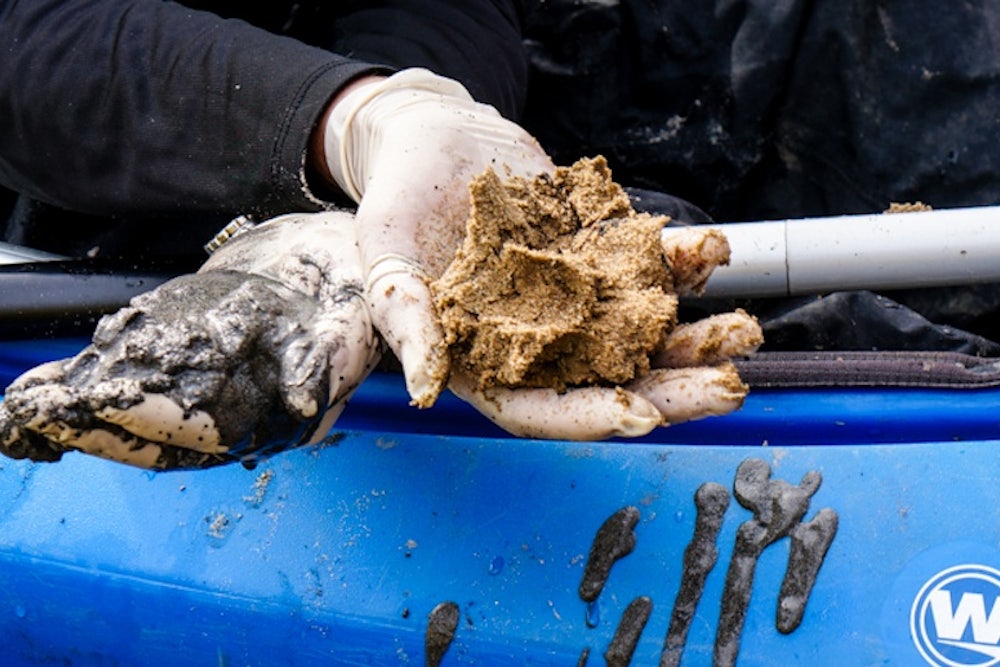The water quality in Sochi’s hotels has been making headlines lately, but that’s nothing compared to what thousands of Americans are experiencing after two recent chemical spills. Communities downriver from Charleston, West Virginia’s Freedom Industries spill still don't have an official consensus about the quality of their drinking water almost a month after the disaster. And on Sunday afternoon, Duke Energy—America’s largest energy corporation—reported a spill of an estimated 82,000 tons of coal ash into the Dan River near Eden, North Carolina.
A chemical waste product from coal combustion, the coal ash was sitting in an unlined dam—essentially, a landfill for combustion waste—when an underground pipe broke, releasing it into the river. Coal ash contains high levels of dangerous heavy metals, including mercury, lead, and arsenic. The Duke power plant stopped operating in 2012, but long before then the Environmental Protection Agency and activist groups had urged Duke Energy to remove its toxic ash heaps.
Duke Energy conducted initial testing of the river and determined the water to be safe for the several thousand people affected by the spill, which spans 25 miles from Eden to southern Virginia. As a result of that test and a North Carolina Department of Natural Resources report, neither North Carolina nor Virginia has mandated tap water bans for affected residents (though, in the report, director of the North Carolina Division of Water Resources concedes, “The Dan River does not have a clean bill of health.”).
But the national Waterkeeper Alliance and its Winston-Salem affiliate, Yadkin Riverkeeper, say those tests might be inconclusive. In an independent test Tuesday, they compared the metal levels in a water sample upstream of the spill to metal levels downriver and found that “arsenic levels immediately downstream of the spill are nearly 30 times higher, chromium levels are more than 27 times higher, and lead levels are more than 13 times higher because of Duke Energy’s coal ash waste.”
Jenny Edwards, the Rockingham County program director of the Dan River Basin Association, has inspected the Dan River every day since the spill, from the Draper Access Point two miles downstream from Eden. “The coal ash is visible," she said. "On Monday, the river was charcoal gray—I’ve never seen it that color before. It was starkly visible.”
Barry Dunkley, director of water and wastewater treatment at Danville Utilities in the affected community of Danville, Virginia, explained that the turbidity of the river water after the spill went from seven Nephelometric Turbidity Units, which is normal, to over 400. Nevertheless, Dunkley said, “We’re confident in our treatment process.”
Plants like Danville Utilities may be able to provide safe drinking water, but the Waterkeeper Alliance says the contaminant metals "will stay in the river, in its sediment, and in the bodies of fish and other animals for a long time to come.” The arsenic levels in the water after the spill were more than twice as high as the Environmental Protection Agency’s exposure criterion for fish and wildlife, the groups says, and many low-income families fish the river. “People with the least responsibility and the least amount of control [over the disaster] should not be bearing the brunt,” said Monica Embrey, a Greenpeace Field Organizer in Charlotte. “The communities who live next to these rivers should be able to do so.”
If the rest of America has been slow to discover the enormity of the Duke Energy spill, that’s because the populations most affected were left in the dark, too. Embrey said that residents and activists she spoke to in Eden never heard about the spill from state or federal officials, but rather from local news stories on Monday evening or from neighbors.
Edwards attributed the lack of official communication to harried state employees. “It’s my sense that state regulatory groups are so busy trying to do their jobs,” she said. “But I can affirm that people are confused and they do have a lot of questions about whether their drinking water is really safe.”
That sounds mighty familiar.
